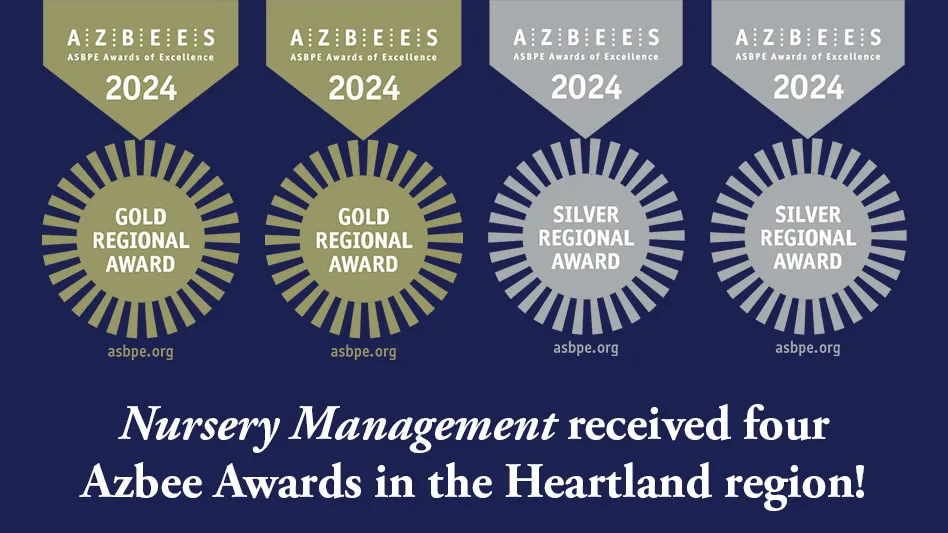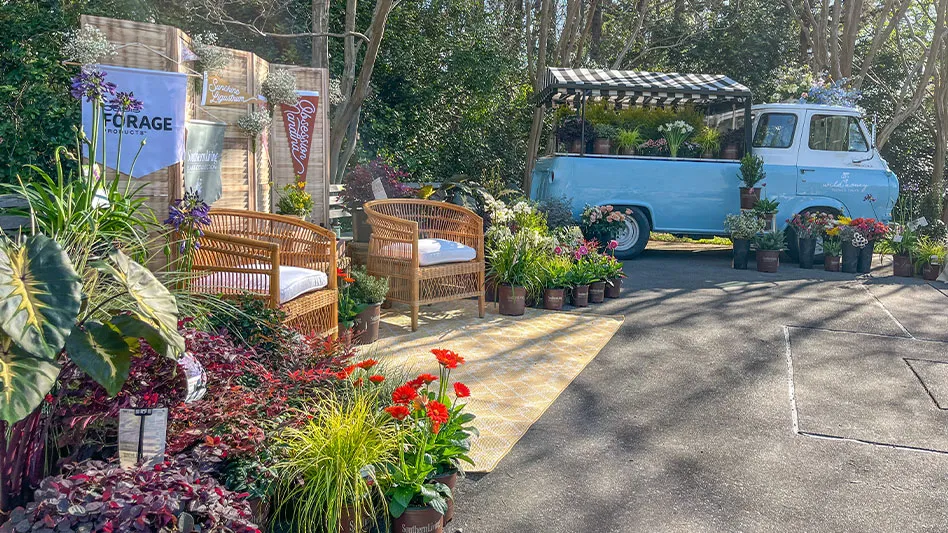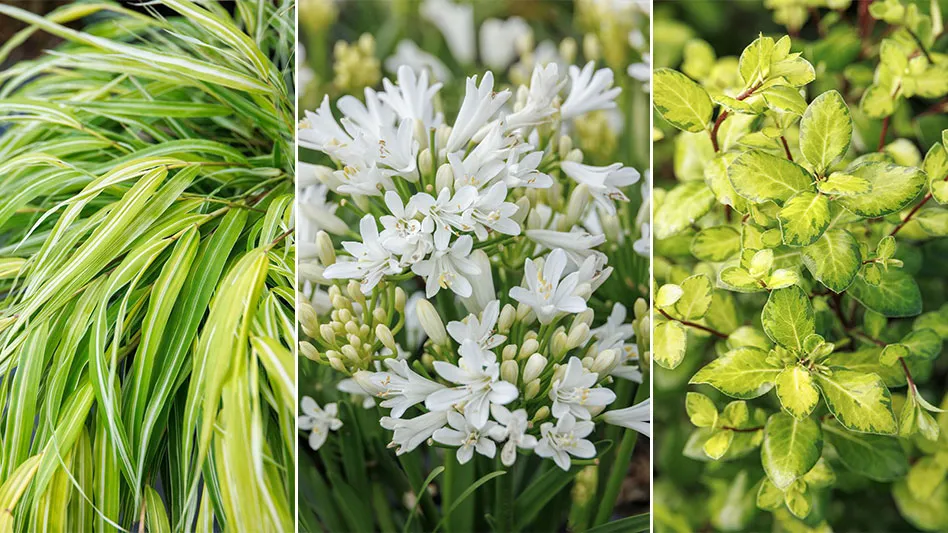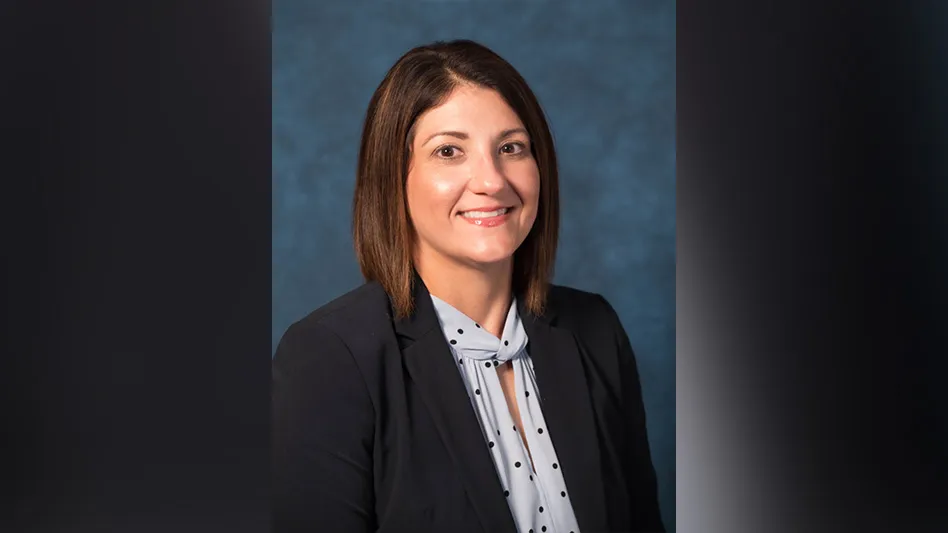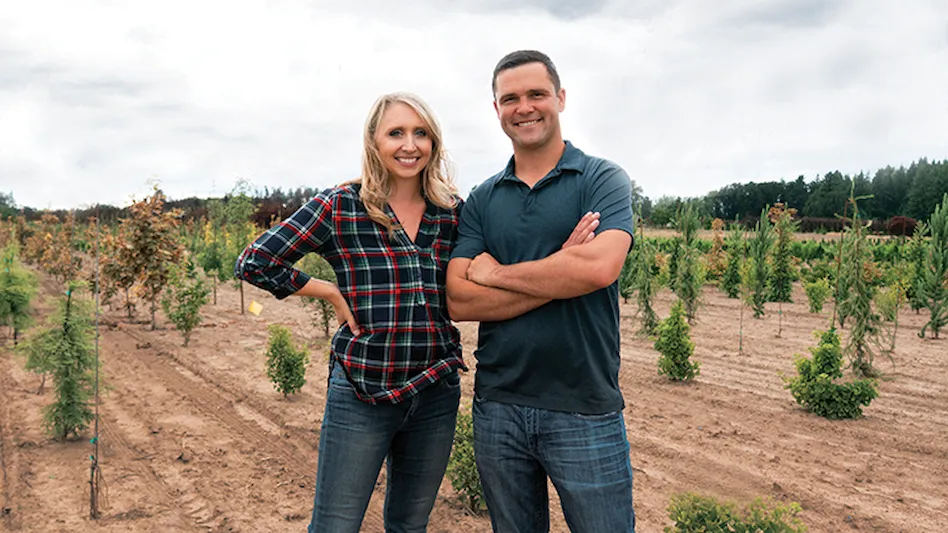

It certainly wasn’t the right time to buy a nursery. But how often does your big break happen when you’re ready for it? Wayne and Amanda Staehely founded Columbia Nursery on a dream and when Wayne’s dream property became available, they couldn’t let it slip by.
Wayne was bitten by the plant bug early. He grew up on a dairy farm in Canby, Ore., but he liked growing. His father’s friend, Steve Germany, ran a wholesale nursery in Canby, and frequent visits served as Wayne’s introduction to the business.
“I’d always go over there when I was a little kid, look at his operation and think ‘Wow, this would be fun to do someday,’” Wayne says.
He worked at retail garden centers in high school and had plenty of friends in the nursery business – including his college roommate, whose father owned a nursery. He transferred to Portland State University to be closer to his girlfriend, Amanda, and he started renting a five-acre spot in Wilsonville, Ore. to “get my feet wet.”
At the beginning, Wayne thought he’d be a propagator because he’d been intrigued by the art of grafting. He’d visit other nurseries, learn what he could and work for free.
“I’d go over to other nurseries and kind of hang out,” he says. “You ask a lot of questions and people teach you things. And then after the first couple of years I’d be grafting by myself and other nurseries would call up and I would go do piece work them or for friends that were behind on a certain variety that was time to graft.”
Wayne would graft for other nurseries during the day and do his own grafting at night. He came to understand the trading and bartering aspect of the nursery business.
“Scion wood is kind of hard to come by even when times are good, especially when you’re starting out,” he says. “If you grow up conifers, you have to have a significant number to produce a significant number of trees. You might get two or three decent pieces of wood off of one tree. And if you’re trying to do production in the nursery business, you really depend on other people that grow the same product to help you out.”
Wayne still dropped by Steve Germany Nursery, where he’d eventually work, first on weekends and later as a manager. Wayne spent a lot of time picking the owner’s brain. He learned a lot from Steve and his connections, which included John Mitsch – pioneer of dwarf conifers and owner of Mitsch Nursery.
“Once you show a little interest, [Steve] said, ‘Well, go talk to this guy. I’ve known him for 20 years.’ That’s how I got to network a lot more in the industry and ask the right questions and find out how to do a lot of things.”

Seize opportunities
By 2007, the couple was engaged, finishing school and outgrowing their own five-acre plot. In a stroke of luck, Wayne’s neighbors, who lived adjacent to his family’s dairy farm, contacted him with a message.
“They said ‘Hey, we’re looking to sell, we know that you need property to start a nursery, would you be interested?’ We said we were interested, and although I was just getting out of school and engaged, we took a big leap of faith and bought that property in Canby,” Wayne recalls.
The young couple remodeled the house and cleaned up the property. The nursery was the next step in their journey, but as it turns out, the Great Recession was right around the corner.
“It was hard when we started,” Amanda says, “because it was really slow in the industry and I think people were really concerned about taking a risk on a young person.”
Not that she necessarily blames them, but it did add to the difficulty of growing a fledgling business.

“It wasn’t an established nursery; they didn’t know how long we’d be around for,” she says. “It’s hard enough in a regular economy. Everyone was nervous to take a chance on us and they didn’t want to be let down.”
Amanda also grew up around the nursery industry, and she has even closer ties than her husband. Her parents own Simnitt Nursery, a wholesale nursery in Canby that specializes in rhododendrons and Pieris. She’s the office manager at Columbia Nursery, and has been a member of the Oregon Association of Nurseries board of directors since 2009, and has served as president of the Clackamas chapter.
Wayne prefers to grow different plant material than what Amanda grew up around. The nursery focuses on field- and container-grown Japanese maples and rare conifers. The decision to expand the focus to smaller deciduous trees as well was made by looking at the current trends in housing – yards are not getting bigger. So Wayne decided to provide colorful trees that won’t become overbearing.
“When I was new to the industry, I’d go around and just see some certain named varieties or certain things that did well and some that look great, but they’re just not going to be a great grower,” Wayne says.
That was enough for him to decide not to grow a particular product. If he knows it’s not going to do well in production, he’ll choose not to grow it because he doesn’t want to have to discipline a customer.
It’s easy to get overwhelmed by cultivar fatigue. Especially when you can look in a Conifer Society book or a conifer encyclopedia and find 15-plus varieties of a slow-growing blue spruce. Wayne suggests whittling that number down, then doing the same thing for a weeping variety or columnar variety.
“What I try to do is, after seeing all these different varieties, single out the cultivar that is going to be the best,” Wayne says. “Then I just keep it true to name and keep the form consistent for the customers so they have a consistent product year over year. You don’t want to grow too many of one variety. Just focus on the best one that you’ve seen. And sometimes that changes. As an industry progresses, you’re always trying out new things for your customers, but you need to be consistent at the same time.”
Wayne chooses to graft his young plants partially by necessity, but partly by choice. Some of the woodier material could be propagated through tissue culture, but it wouldn’t be worth the time he would have to put into it. Cuttings aren’t always possible for woodier items; they grow slower and not as well on their own rootstock.
Sometimes he buys liners to bring in new stock or new varieties. But you aren’t guaranteed to receive what you order in the amount you ordered. For instance, if he’s looking for a particular blue spruce, grafting offers more certainty.
“You know the scion wood that you’re getting. If I order a ‘Fat Albert’ from a nursery, they could have been confused with ‘Backeri’ or ‘Hoopsi’ and so you don’t have to deal with the misnaming of varieties. And when you’re grafting it’s really up to you. But the reason I graft is because I enjoy doing it. It’s kind of a niche.”
When he grafts, he’s able to dictate his own numbers and create a hardier plant for his customers.
“Grafting isn’t just the motion of cutting the plant and picking the right scion,” Wayne says. “It’s the aftercare as well. There’s a lot more than you think. It’s not just a numbers game for that day. You’re not going to get anything to take if you don’t go into it with the aspect of ‘This is a living thing. I need to nurture it and really care for it until it gets established.’”

Another bold move
As the Staehelys managed to keep their business afloat through the recession and grow as a family, another opportunity arose. It was 2013 and Steve Germany, Wayne’s mentor, wanted to retire. He didn’t have any children and wanted to sell his business.
It represented a huge expansion for Columbia Nursery, but it happened within perhaps the craziest six-week span of the Staehelys’ lives.
They were finishing a large remodel on their house, the infrastructure on the existing nursery had just started to really come together and, to cap it all off, they had just had their first baby.
“It really was his dream,” Amanda says. “Like, he grew up with this guy. He was the one who gave him his first plant. It was kind of Wayne’s dream property, to be honest. And it was something we couldn’t pass up. He approached us and we had to do it then and make a big choice. But we did it and that’s why we did it.”
It may have been Wayne’s dream, but it wasn’t always Amanda’s.
“My parents had a nursery, so growing up I used to swear that I would never do this to my kids,” she says. “Spring break? We’re always going to go on vacation. That’s what I thought. I couldn’t believe that I was stuck at home every spring break while my dad was shipping out plants. Lo and behold, I guess it didn’t work out like that.”

The Staehely family has the hectic life of young parents, but with the added degree of difficulty that comes from being entrepreneurs. Both Wayne and Amanda work other jobs in addition to running the nursery. Amanda runs a pilates studio and manages the ballet portion of a dance studio in Canby.
The couple has three children, five-year-old Luke, two-year-old Emma and 11-month old Grant. Of course, having the kids are around complicates running a business, but it also makes it fun. They love getting their hands dirty, and they’ve been involved in nearly every aspect of the nursery’s work – save spraying.
“If a main line breaks, my five-year-old is out there helping us put that pipe back together,” Amanda says. “My daughter is playing in the office with me while we work and the 11-month-old takes naps in his pack and play.”
There’s really no other way it can work. The Staehelys receive lots of help from family and friends – their “army.”
Wayne and Amanda like that their children are growing up outdoors in an industry that is nurturing by nature. Not every kid gets to ride on the tractor with dad. They still face many challenges, as all nursery growers do. The No. 1 challenge is increasing labor costs.
“There’s just not as many people that want to do farm labor and that is absolutely the hardest,” Amanda says. “We’re constantly searching for more employees.”
Currently, Columbia has three full-time employees and three part-time employees. If they had their way, they’d have more to help with the heavy lifting. Some of their specimen conifers are 16 feet tall and 1,000 pounds.
“You can’t just load a truck with one or two people,” Wayne says. “You need some good numbers during shipping season. That tends to be when it’s the hardest to find people.”
Labor and legislation go hand-in-hand, and the current state legislature in Oregon has made life tougher for businesses like Columbia Nursery, Amanda says. That’s why she’s gotten more involved with the OAN.
“The OAN does so much, as far as lobbying against certain things, and we need it,” she says. “There were some bills this year that really could have crippled us and potentially shut us down if they had passed.”
Most of Columbia Nursery’s plant material is shipped east or to Canada. Rewholesalers and independent garden centers are the nursery’s main customers. After the 2013 expansion, Columbia has 120 acres available. They usually keep about 80 acres in production.
“People seem to be every year progressively more excited about plant material,” Wayne says. “When construction is good, the economy is good. Everybody gets excited and therefore you get more excited because you see the plants leaving more frequently.”
For more: www.columbia-nursery.com

Explore the August 2019 Issue
Check out more from this issue and find you next story to read.
Latest from Nursery Management
- CIOPORA appoints Micaela Filippo as vice secretary-general
- Registration opens for Darwin Perennials Day
- April 2024 issue recap
- U.S. Department of Labor finalizes farmworker protection rule
- Azo Root is now available from Harrell’s
- Smith Gardens assumes operations of Skagit Horticulture
- Garden Media Group announces the fifth annual Women in Horticulture Week
- Eason Horticultural Resources announces the addition of Phil Perry

